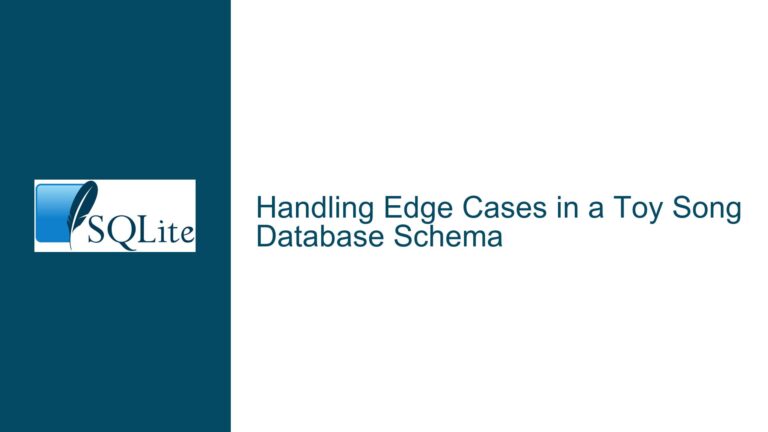SQLite Views: Storage, Compilation, and Parameterization
SQLite Views: Stored as Plain Text and Compiled at Runtime
SQLite views are stored in the sqlite_master table as plain text SQL strings. When a view is created, its definition is saved in the sqlite_master table under the sql column. This definition is the exact SQL statement used to create the view. For example, if you create a view named myname with the SQL statement CREATE VIEW myname AS SELECT * FROM mytable, the sqlite_master table will store this statement as plain text.
The key point here is that SQLite does not store a pre-compiled or binary representation of the view. Instead, the view’s SQL statement is parsed and converted into an internal representation each time the schema changes or when the database connection is first opened. This internal representation is then used for subsequent queries involving the view.
This design choice has several advantages. First, it simplifies the SQLite database file format, making it easier to document and understand. Second, it allows the SQLite development team to change the internal representation of views for performance improvements, new features, or bug fixes without breaking backward compatibility with existing database files. This flexibility is crucial for maintaining SQLite’s reputation for stability and reliability.
However, this design also means that views are not pre-compiled or optimized at the time of creation. Instead, the optimization and compilation happen at runtime, which can lead to a slight overhead when the view is first accessed after a schema change or database connection. This overhead is generally minimal but is something to be aware of when designing performance-critical applications.
Limitations of SQLite Views: Lack of Parameterization and Complex Queries
One of the most significant limitations of SQLite views is that they cannot be parameterized. In other words, you cannot create a view that accepts parameters at runtime. This limitation can be a hurdle for developers who are used to working with parameterized queries in other database systems like Microsoft SQL Server or MySQL.
For example, in SQL Server, you can create a stored procedure or a parameterized view that accepts input parameters and returns results based on those parameters. This capability is not available in SQLite views. If you attempt to create a view with parameters, SQLite will reject it, as the SQL syntax for views does not support parameterization.
Another limitation is that while SQLite views can include complex queries, including joins, they are still read-only. You cannot perform INSERT, UPDATE, or DELETE operations directly on a view. This limitation is by design, as views are intended to provide a way to encapsulate complex queries and present them as virtual tables. However, it can be a constraint for developers who need to perform write operations on the results of a view.
Despite these limitations, SQLite views are still powerful tools for encapsulating complex queries and simplifying database access. They can include joins, subqueries, and other advanced SQL features, making them versatile for a wide range of use cases. However, developers need to be aware of these limitations and plan their database designs accordingly.
Implementing Workarounds for Parameterized Views and Complex Queries
While SQLite views do not support parameterization natively, there are workarounds that can achieve similar functionality. One such workaround involves using a "magnet" virtual table. A magnet virtual table is a special type of table that returns a single row with a value constrained by the query. This value can then be used in a view to simulate parameterization.
For example, consider the following SQL statements:
CREATE VIEW a(b, c) AS SELECT value * value, value FROM magnet(value);
SELECT b FROM a WHERE c = 5;
SELECT b FROM a WHERE c = 6;
In this example, the magnet virtual table returns a single row with the value constrained by the query. The view a then uses this value to perform calculations and return results. While this approach is not as straightforward as native parameterization, it provides a way to achieve similar functionality in SQLite.
Another workaround for complex queries is to use Common Table Expressions (CTEs) or subqueries within views. CTEs allow you to define temporary result sets that can be used within a larger query. This capability can be particularly useful for breaking down complex queries into more manageable parts.
For example, consider the following SQL statement:
WITH cte AS (
SELECT * FROM mytable WHERE column1 = 'value'
)
SELECT * FROM cte JOIN another_table ON cte.id = another_table.id;
In this example, the CTE cte defines a temporary result set that is then used in a join with another table. This approach can be used within a view to encapsulate complex logic and simplify the overall query.
Additionally, developers can use the CREATE TABLE ... AS SELECT syntax to create a new table from the results of a query. This approach is different from creating a view, as it creates a physical table that stores the results of the query at the time of execution. Subsequent changes to the underlying tables are not reflected in the new table, making this approach suitable for scenarios where you need a static snapshot of the data.
For example:
CREATE TABLE t1 AS SELECT i FROM t0;
This statement creates a new table t1 with the results of the query SELECT i FROM t0. Any changes to t0 after this statement is executed will not be reflected in t1. This approach can be useful for creating temporary tables or snapshots of data for reporting or analysis purposes.
In conclusion, while SQLite views have some limitations, particularly around parameterization and write operations, there are several workarounds and techniques that can be used to achieve similar functionality. By understanding these limitations and leveraging the available tools, developers can effectively use SQLite views to encapsulate complex queries and simplify database access.






